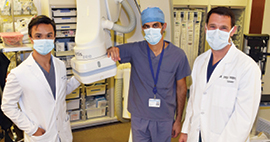A Fitting Fortune
Vacaville resident Ted Neima keeps a small slip of paper in his wallet — a fortune cookie message he got the night before he had a valve in his heart surgically replaced.
“Look forward to great fortune and a new lease on life,” it reads and Ted says that sums up his experience at NorthBay Health just perfectly.
 Ted got his new lease thanks to a minimally-invasive heart procedure offered at NorthBay Health known as Transcatheter Aortic Valve Replacement (TAVR) which provides an alternative to traditional open-heart surgery.
Ted got his new lease thanks to a minimally-invasive heart procedure offered at NorthBay Health known as Transcatheter Aortic Valve Replacement (TAVR) which provides an alternative to traditional open-heart surgery.
It was no surprise to him that he needed the surgery. The Vacaville business owner said he had been diagnosed with a developing aortic stenosis years before and the condition had been treated with medications and monitored by his cardiologist Cyrus Mancherje, M.D., who had explained that there would come a point where the problem would require a valve replacement. An aortic stenosis is a condition in which his heart’s aortic valve thickens and becomes stiff (calcified) so that it can’t fully open to allow blood flow from the heart into the body.
“If I’m honest, I can remember laying on my side at night in bed and listening to my heart beat and I could hear it squishing as it pumped,” he says.
The condition left him feeling fatigued and often out of breath, he said. “I would send my employees to the store to shop or send them to run errands for me because I just couldn’t do it,” he said.
When it became clear that the time for a valve replacement had arrived, Ted was connected with NorthBay interventional cardiologist Saba Lahsaei, M.D. “Mr. Neima’s condition really couldn’t wait,” Dr. Lahsaei said. “With aortic stenosis, the valve opening is narrowed, the heart has to work harder to pump enough blood to the body. That extra work can cause the left ventricle to thicken and enlarge and eventually the strain can cause a weakened heart muscle which can ultimately lead to heart failure.”
The TAVR procedure involves a thin, flexible catheter tube that is inserted into a blood vessel via a small incision on the leg and then guided into the heart. Moving X-ray images help the doctor place the catheter into the correct position and then a replacement valve is passed through the catheter and placed in the area of the aortic valve. A balloon on the catheter tip inflates, to press the new valve into place. The year 2022 marks the 20th anniversary of the first-ever TAVR procedure, which was done in France.

Because it is minimally invasive, TAVR patients are generally able to go home within a day or two of the procedure. In Ted’s case, he spent a night in the hospital for observation and was able to go home the next day, said Dr. Lahsaei.
“TAVR is a great advancement in heart care,” said Dr. Lahsaei. “It is far less invasive than open-heart surgery, leaves only a small scar and poses a lower risk of infection with a much faster recovery time.” Dr. Lahsaei and fellow interventional cardiologist Mark Villalon, M.D., each performed hundreds of TAVR procedures prior to joining NorthBay in 2019. Along with cardiovascular surgeon Shea Pribyl, M.D., and a cardiac catheterization team, they have performed about 50 in the past two years at NorthBay Health Medical Center where a new state-of-the-art hybrid operating room is used for the specialized procedure.
“When they took me in for the surgery and I looked at the room with its high tech equipment and computer screens, I mean, I’ve never seen anything like it,” Ted recalled. “It was beyond Star Wars!”
And he said he still is impressed by how organized and caring his entire Heart & Vascular team was — from the medical assistant that made sure his calls were returned, to the nursing staff and the anesthesiologist who held his hand and helped keep him calm and comfortable.
“That’s one thing people need to understand — it’s a team of people,” Ted said. “From my first appointment with him, Dr. Lahsaei laid everything out for me, explained it all using a tech board that he could draw on and he made it all make sense for me. And there was a whole team meeting about my case. I realized that when Dr. Villalon was in the operating room too.”
He calls his experience a “God send” and said the same is true for the team in NorthBay Cardiac Rehabilitation who helped him with recovery and learning to follow a healthy diet and exercise regime.
“It really has changed my life. I have so much more energy. I don’t have to send my employees out to do things for me because I can do it myself now,” he said. “I will say that when I think about it all, I get emotional. I am so grateful and I’m doing great. It takes me back to that fortune cookie — I got a new lease on life.”
For more information on TAVR and NorthBay Heart & Vascular, visit NorthBay.org/TAVR.








